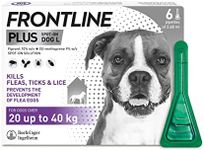Buying Guide for the Best Flea Treatments For Dogs
Choosing the right flea treatment for your dog is crucial for their health and comfort. Fleas can cause a range of issues from mild itching to severe allergic reactions and even transmit diseases. When selecting a flea treatment, it's important to consider various factors to ensure you pick the best option for your furry friend. Here are some key specifications to help guide your decision.Type of TreatmentFlea treatments come in various forms such as topical treatments, oral medications, flea collars, and shampoos. Topical treatments are applied directly to the dog's skin and are effective for about a month. Oral medications are ingested and can provide protection for up to three months. Flea collars release chemicals that repel fleas and can last several months. Shampoos provide immediate relief but need to be used frequently. Choose the type based on your dog's lifestyle and your convenience.
Active IngredientsThe active ingredients in flea treatments are what kill or repel fleas. Common ingredients include fipronil, imidacloprid, and permethrin. Some ingredients are more effective against adult fleas, while others target eggs and larvae. It's important to choose a treatment with ingredients that address the specific flea life stage affecting your dog. If your dog has sensitive skin or allergies, consult your vet for a recommendation on the safest ingredients.
Duration of EffectivenessThe duration of effectiveness refers to how long the treatment will protect your dog from fleas. Topical treatments and oral medications typically last for one to three months, while flea collars can last up to eight months. Shampoos provide short-term relief and need to be used more frequently. Consider how often you are willing to administer the treatment and choose one that fits your schedule and your dog's needs.
Dog's Age and WeightFlea treatments are often formulated based on the age and weight of the dog. Puppies and small dogs require different dosages compared to adult and larger dogs. Using the wrong dosage can be ineffective or even harmful. Always check the product label for age and weight recommendations and choose a treatment that is appropriate for your dog's specific characteristics.
Ease of ApplicationEase of application is an important factor to consider, especially if your dog is fidgety or uncooperative. Topical treatments require you to part the fur and apply the liquid directly to the skin, which can be tricky with a squirmy dog. Oral medications can be hidden in food, making them easier to administer. Flea collars are simple to put on but need to be adjusted for comfort. Choose a treatment that you can apply easily and consistently.
Additional BenefitsSome flea treatments offer additional benefits such as protection against ticks, heartworms, and other parasites. These multi-purpose treatments can be more convenient and cost-effective. If your dog is at risk for multiple types of parasites, consider a treatment that provides broader protection. Always consult your vet to ensure the additional benefits are necessary and safe for your dog.


















